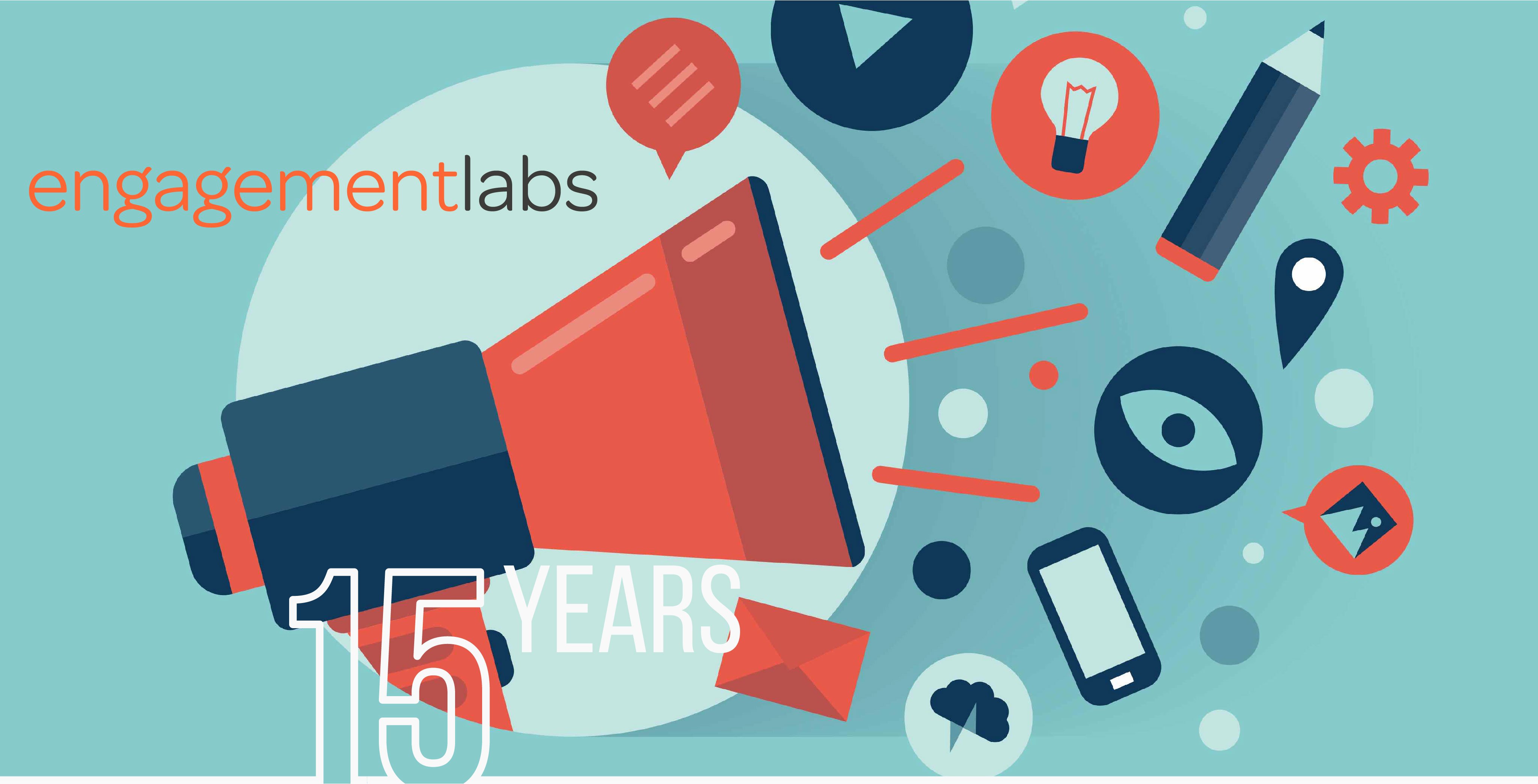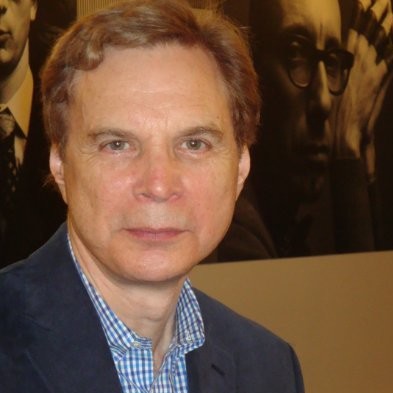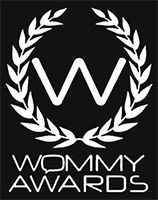
It’s our 15th Anniversary. Making it 15 years as a business is a pretty good excuse to celebrate and recognize a few of our advocates who are innovators and acclaimed marketing leaders. We are hoping that this year’s anniversary can be a great opportunity to look back – as we also look forward – and inspire during an otherwise tumultuous year.
We caught up with four of our earliest clients who share their expertise and thoughts on the importance of consumer conversation data and word-of-mouth marketing in driving business outcomes.
We hope you enjoy the following Q&A interviews conducted by Ed Keller, CEO of Engagement Labs. Click on the names to read the entirety of each interview.
Kate Sirkin, EVP, Global Data Partnerships at Publicis Epsilon
Kate was formerly EVP Research at Starcom MediaVest Group, and our first client.
On deploying WOM as part of communications and media planning or evaluation
“I think there were 3 main ways we deployed the learning at SMG
- We formalized the need to include WOM in our accountability work, both on and offline, how much volume and what was the positive/negative splits over time.
- We formalized the need to include both on and offline in our communication planning insight work, how and in our insight work, what was driving the WOM – topics, sources, people
- We used the data for important but ad hoc questions that came up over time, for example to see how much the financial crisis in 2008-9 and the ad spend of the companies in those categories impacted two significant industries (auto and finance) in terms of brand favorability and advocacy. We used the data to support of continued ad spend but changes in strategy for the brands that we worked on.”
Click here to read Kate's full Q&A interview.
Greg Pharo, Global Director, Media Analytics & Advertising Research at The Coca-Cola Company
Greg was formerly Director, Marketing Science / Market Research & Analysis at AT&T Mobility, one of the first brands to add WOM data to market mix models.
On value of word-of-mouth research/insights and undertaking serious modeling with Engagement Labs word of mouth data
“There were three very important findings. The most important one was that WOM was almost as important as media in driving sales. Second, we found that WOM works both ways: positive WOM increases sales, while negative WOM subtracts from sales. And third, there are significant synergy interactions between WOM and advertising: advertising generates additional conversations, and conversations make advertising more effective at driving sales.”
On social media and its relationship to offline WOM
“It’s like breathing: we have two lungs and we need to use both of them. Social conversations are important, but offline WOM is even more important. We should measure both using fit-for-purpose methods and understand that integrated marketing communication planning requires both to succeed.”
Click here to read Greg's full Q&A interview.
Gregg Liebman, Head of Research at Home Team Sports, a division of Fox Sports Media Group
 On importance of word-of-mouth today and how the advertising world embraces it
On importance of word-of-mouth today and how the advertising world embraces it
“I think today word of mouth is more important than ever, as consumers have become increasingly wary of “fake news” and product reviews. I am concerned that the industry mistakenly views social conversation as word of mouth. As Engagement Labs proves daily, the overwhelming majority of brand conversations do not occur online. Word of mouth is still driven by face to face (or Zoom) conversations between friends and family. Word of mouth continues to be the #1 influencer on purchase decisions. NUMBER ONE!!!”
Click here to read Gregg's full Q&A interview.
Graeme Hutton, SVP, Group Partner, Research at Universal McCann
 On word-of-mouth measurement and use of Engagement Labs data
On word-of-mouth measurement and use of Engagement Labs data
“What struck us was that WOM was not just driven by the brand’s advertising, there were competitive brand interactions too. This meant that a brand’s WOM didn’t just depend on its advertising and other activities, it could be eroded by competitive marketing communications too.
We also included a brand’s WOM weekly data in our Marketing Mix Models, and we clearly saw its sales impact there in two ways. First, advertising drove both sales and WOM, but, interestingly, second, the WOM also subsequently drove sales as consumers talked about the brand.”
Click here to read Graeme's full Q&A interview.
Full Q&A Interviews with Ed Keller
Kate Sirkin
Keller: Hi Kate. It’s been 15 years since we launched what was then called TalkTrack. Social media listening was just beginning with firms like BuzzMetrics; we were the first to measure offline word of mouth. You and your colleagues at Starcom Mediavest were very enthusiastic about the idea and became our first client. First, I want to say thank you. I am forever grateful.
Can you think back to 2005 and recall what made you and your clients interested in word of mouth at that time? Who were the clients who were most interested and why?
Sirkin: We were aware of the importance of word of mouth both on and offline from our channel planning tools (Market Contact Audit/Touchpoints) and while we had good social data, we did not have a continuous way to track the volume and quality of the off line word of mouth for our client’s brands and categories. We had very particular interest in the travel, electronics and beverage categories.
Do you recall what was particularly valuable/notable about our word of mouth research/insights?
Sirkin: A few items were particularly interesting, the volume of word of mouth and the differences by category and the variability over time, which helped us in our measurement work. Additionally we saw the large differences in the technology category between online and offline which helped us to develop strategies to take advantage of the online conversations and leverage them in offline media to drive more offline conversations.
How did the agency deploy WOM as part of your comms and media planning or evaluation? Many people still wonder whether word of mouth can in fact be activated. So any insights you can share about then . . . and now . . . are appreciated.
Sirkin: I think there were 3 main ways we deployed the learning at SMG
- We formalized the need to include WOM in our accountability work, both on and offline, how much volume and what was the positive/negative splits over time.
- We formalized the need to include both on and offline in our communication planning insight work, how and in our insight work, what was driving the WOM – topics, sources, people
- We used the data for important but ad hoc questions that came up over time, for example to see how much the financial crisis in 2008-9 and the ad spend of the companies in those categories impacted two significant industries (auto and finance) in terms of brand favorability and advocacy. We used the data to support of continued ad spend but changes in strategy for the brands that we worked on.
How do you see things today? Is word of mouth more or less important? How has it evolved?
Sirkin: Still super important but definitely more balanced between on and offline and a significantly better understanding of who and what is being talked about and the importance of a strategy and measurement for each.
How do you think about social media and its relationship to offline WOM?
Sirkin: Much more closely connected but driven by different sectors of the population
You are now with Publicis Epsilon. Do you see WOM’s importance as part of your data stack?
Sirkin: Not sure yet, for the work I do. Something to dive into more in 2021.
Greg Pharo
Keller: Hi Greg. It’s been 15 years since we launched what was then called TalkTrack. Social media listening was just beginning with firms like BuzzMetrics; we were the first to measure offline word of mouth. You and your colleagues at AT&T were very enthusiastic about the idea and became early and long-term clients. First, I want to say thank you. I am forever grateful.
Can you think and recall what made you interested in word of mouth at that time?
Pharo: Ed, our customers kept telling us that that recommendations and advice from friends and family were major reasons for switching carriers or getting a new type of mobile phone. We knew that word of mouth propelled our business, but we didn’t have a way to measure it or diagnose what types of conversations consumers were having about us and competing brands. So as soon as some of us in the market research department at AT&T/Cingular heard about TalkTrack we were very excited. Fran Linnane, our new head of market research, decided to give it a try – this was right before Apple decided to launch the first iPhone. We were playing in the hottest consumer category at the time, and its was absolutely necessary to have an insightful yet disciplined approach for understanding conversations and recommendations.
Do you recall what was particularly valuable/notable about our word of mouth research/insights? In particular, you were the first client do undertake serious modeling with our word of mouth data. What did you find and why were the findings significant to AT&T?
Pharo: We were getting a lot of value using TalkTrack for diagnosing consumer conversations. And, as a marketing scientist, I was particularly intrigued by the depth and richness of the TalkTrack data set. It got me thinking that TalkTrack’s WOM could be added into our AT&T Market Mix Model, side by side with media, pricing, distribution and other causal factors. We introduced the TalkTrack data into our MMM, and it went right in – it actually improved the model by reducing base effects and explaining more of our sales.
There were three very important findings. The most important one was that WOM was almost as important as media in driving sales. Second, we found that WOM works both ways: positive WOM increases sales, while negative WOM subtracts from sales. And third, there are significant synergy interactions between WOM and advertising: advertising generates additional conversations, and conversations make advertising more effective at driving sales.
A few years later we decided to try a new type of market mix modeling to see if media and WOM could explain not only our sales but also explain customer churn rates, Our hypothesis was that advertising might decrease churn and that negative WOM could increase it. We constructed what may have been the first churn-based MMM in our industry, and found that TalkTrack WOM data had a causal relationship to customer defections. Positive WOM was mathematically related to lowering churn, and negative WOM conversation increased it. Advertising also played a role in churn reduction: but our own advertising was much better at generating sales (new customers) than preventing customer churn, and customer service and product quality and pricing were important churn-determining factors.
What changes to marketing or media strategy and execution did AT&T do as a result of the models that showed the importance of Word of Mouth?
Pharo: We immediately realized the need to make our messages buzzworthy: make ads that people want to discuss and share with others. It became clear that ads which people talked about drove higher sales. It was one of the factors that inspired us to come up with more memorable characters in our ads and to use certain types of humor that got audiences laughing, talking and sharing.
You were at AT&T when we started working together and now you are at Coca-Cola. Decisions about wireless purchases are considered purchases which you might expect word of mouth would help influence. What about at a fast-moving consumer good company such as Coke. Is WOM important in soft drinks as well, and if so why do you feel that is?
Pharo: Beverages and telecommunications are about as far apart as categories can be. And yet, WOM is just as important for Coca-Cola as it is for AT&T. While beverages are considered “low consideration” purchases the truth is that people care a lot about what they put into their bodies – and they develop strong emotional attachments to food and drink. And what better way to understand emotions than to listen to what people are talking about? In fact, we have some of the most discussed brands in the world, with very high Brand Love scores. WOM is a wonderful way to understand dhow our brands motivate and impact consumers; which ad campaigns resonate with them; and how sponsorships activate consumer behavior.
How does Coca-Cola look at the measurement of WOM and its role in marketing strategy and planning?
Pharo: We aspire to have consumers love our brands. It’s not just about the purchase – it’s about the passion. Tracking emotional intensity requires more than just measuring impressions or shopping basket: we have to know what consumers feel deep inside if we are to understand what they love and what beverage experiences they desire. And what better way to do so than by listening to what they have to say? Social listening goes a long way – but we prefer to listen to consumers across all modes of conversation and all types of experiences. The voice of the consumer shapes new product plans, flavor formulation, packaging, distribution, brand personality, and so many other aspects of our brands.
How do you see things today? Is word of mouth more or less important? How has it evolved? And how has the corporate embrace of word of mouth changed?
Pharo: One of the biggest trends today is for companies to diversify beyond paid advertising for brand communication. We measure not just paid media impressions but also Earned and Owned interactions. WOM is the most significant form of Earned interactions, and C-suite executives increasingly want to activate a balanced approach to brand messaging using Paid-Owned-Earned. Brands are increasingly aware that experiential marketing holds great promise. There is not Nielsen-measured GRP for consumer experiences - but WOM is an excellent way to quantify and diagnose large-scale, sustained experiential marketing campaigns.
How do you think about social media and its relationship to offline WOM?
Pharo: It’s like breathing: we have two lungs and we need to use both of them. Social conversations are important, but offline WOM is even more important. We should measure both using fit-for-purpose methods and understand that integrated marketing communication planning requires both to succeed.
Gregg Liebman
Keller: Hi Gregg. It’s been 15 years since we launched what was then called TalkTrack. Social media listening was just beginning; we were the first to measure offline word of mouth. When you were at CNN you were very enthusiastic about the idea and became early and important client. First, I want to say thank you. I am forever grateful.
Can you think and recall what made you interested in word of mouth and our work, at that time?
Liebman: My role at CNN was to support their cross-platform ad sales efforts. We were looking for a syndicated solution to demonstrate the value of CNN viewers as influencers or brand ambassadors.
Do you recall what was particularly valuable/notable about our word of mouth research/insights? And what the particular value was to CNN?
Liebman: Part of our positioning at that time was that news is “social currency” and those in the know not only discuss politics, weather, news, etc., but are the same people evangelizing goods and services. The ability to report on Influencers at the brand level was unique and a compelling point of differentiation for TalkTrack.
After you left CNN you became a client again at Telemundo. What do you recall about word of mouth among Hispanics and how it helped with ad sales there?
Liebman: Hispanics were quickly becoming the “it” crowd - leading significant cultural change in the U.S. TalkTrack was a third-party respected data source that enabled us to quantify (put numbers) to this narrative. The data proved that Hispanics were leading the conversations about brands across every measured category. Our “Los Influyentes” presentation was highly effective in raising the importance of reaching Latinos beyond just their collective spending power. It was one of the sales initiatives I am most proud of.
How do you see things today? Is word of mouth more or less important? And how has the advertising world’s embrace of word of mouth changed?
Liebman: I think today word of mouth is more important than ever, as consumers have become increasingly wary of “fake news” and product reviews. I am concerned that the industry mistakenly views social conversation as word of mouth. As Engagement Labs proves daily, the overwhelming majority of brand conversations do not occur online. Word of mouth is still driven by face to face (or Zoom) conversations between friends and family.
How do you think about social media and its relationship to offline WOM?
Liebman: I think it’s fascinating that, according to your data, the two typically act independent of each other. I think offline WOM deserves the same, if not more, attention from Marketers than social media. Unfortunately, for most marketers, this is not the case.
Is there anything else you’d like to add about the value of word of mouth and our measurement system?
Liebman: Word of mouth continues to be the #1 influencer on purchase decisions. NUMBER ONE!!! The ability to see which media environment drives these valuable conversations should play a significant factor in media selection. Media agencies would be well-served to incorporate WOM measurement into their proprietary models. It might not be new and “sexy”, but WOM drives purchase decisions. It always has and it always will!
Graeme Hutton
Keller: Hi Graeme. It’s been 15 years since we launched what was then called TalkTrack. Social media listening was just beginning with firms like BuzzMetrics; we were the first to measure offline word of mouth. You and your colleagues at UM were very enthusiastic about the idea and became early and long-term clients. First, I want to say thank you. I am forever grateful.
Can you think and recall what made you and your clients interested in word of mouth at that time? Who were the clients who were most interested and why?
Hutton: What triggered the interest in face-to-face word mouth, WOM, was the novelty of being able to track something that had previously often been thought of as untrackable. In other words, to know the previously unknowable, to quantify the unquantifiable.
At the time Engagement Labs started, back in 2005, the relationship between advertising and WOM was not yet proven. Consequently, it was great to have a weekly series of consumer response data on WOM because we could align it to our weekly media weight and assess the relationship between the two.
What was immediately apparent was that there was not a linear relationship between word of mouth, and an ad campaign but a multivariate one. In other words, looking solely at a brand’s total weekly media spend or weight did not yield a clear relationship with WOM. But a multiple regression showed an immediately different picture – even a simple multiple regression in Excel would reveal a clear relationship by media channel. Critically, the effect of advertising on WOM wasn’t dependent on the total media spend or activity, the impact on WOM varied by media channel. Typically, video and digital led this impact.
We tended to focus on clients who were in high interest categories since it was easier to demonstrate the effect.
Do you recall what was particularly valuable/notable about our word of mouth research/insights?
Hutton: Yes, what was useful was to see, in any category, for example spirits, what was the relative lift in WOM caused by advertising for each brand.
Some brands’ WOM was much more responsive to media advertising than others. This could be used as a measure of the relative ad effectiveness of a specific brand in a category. It provided a comparative metric of the ‘vibrancy’ or power of advertising for each brand.
You used our data in your media models and found them to be good predictors of consumer behavior. Can you discuss what you did, what you found, and what it caused you to conclude about word of mouth and our word of mouth measurement?
Hutton: What struck us was that WOM was not just driven by the brand’s advertising, there were competitive brand interactions too. This meant that a brand’s WOM didn’t just depend on its advertising and other activities, it could be eroded by competitive marketing communications too.
At this time, little was understood about the power of advertising in driving WOM, indeed did it exist at all. Now we could see for a brand’s advertising that it definitely lifted its level of WOM. Advertising’s lift varied by brand. The first time we assessed it in detail, we saw a lift of about +30%, but equally it could be eroded by the competitive spend with the net effect that the actual level attributable to advertising was halved to just +15%. In other words, the impact of competitive Share of Voice was very visible and almost visceral!
We also included a brand’s WOM weekly data in our Marketing Mix Models, and we clearly saw its sales impact there in two ways. First, advertising drove both sales and WOM, but, interestingly, second, the WOM also subsequently drove sales as consumers talked about the brand.
How do you see things today? Is word of mouth more or less important? How has it evolved?
Hutton: The world has shifted quite dramatically with the introduction of influencer marketing from about 2015. Previous to this, the industry often spoke about viral marketing, which currently is hardly referenced at all. Influencer marketing is a direct way of triggering consumer involvement. Today, UM has clear, undeniable evidence of how this new type of activation can directly influence a consumer’s consideration of a brand.
As a result, influencer marketing has really come to the fore. One excellent book capturing the moment of change was Hit Makers by Derek Thompson, published in 2017. Hit Makers was to influencer marketing what Malcom Gladwell’s The Tipping Point, over a decade earlier, was to understanding the viral growth of a fan base and the general virality of trends. Hit Makers cleverly dissected the underlying reasons of how and why social media could be harnessed by one person, an influencer, who had an online following of millions to drive true influencer marketing and help build sales.
We have real evidence to show that influencer marketing definitely drives the middle to lower end of the purchasing funnel. This is not to deny some of the criticisms of influencer marketing, but the principle of this form of word-of-mouth marketing definitely holds true.
Is there anything else you’d like to add about the value of word of mouth and our measurement system?
Hutton: One other area I like about the weekly tracking of face-to-face WOM is that it unambiguously tells us the consumer sentiment of a brand, and this also extends to detailed demographics, age, gender and so forth. This provides us with an important validation of the viral impact of our media and related activities.






